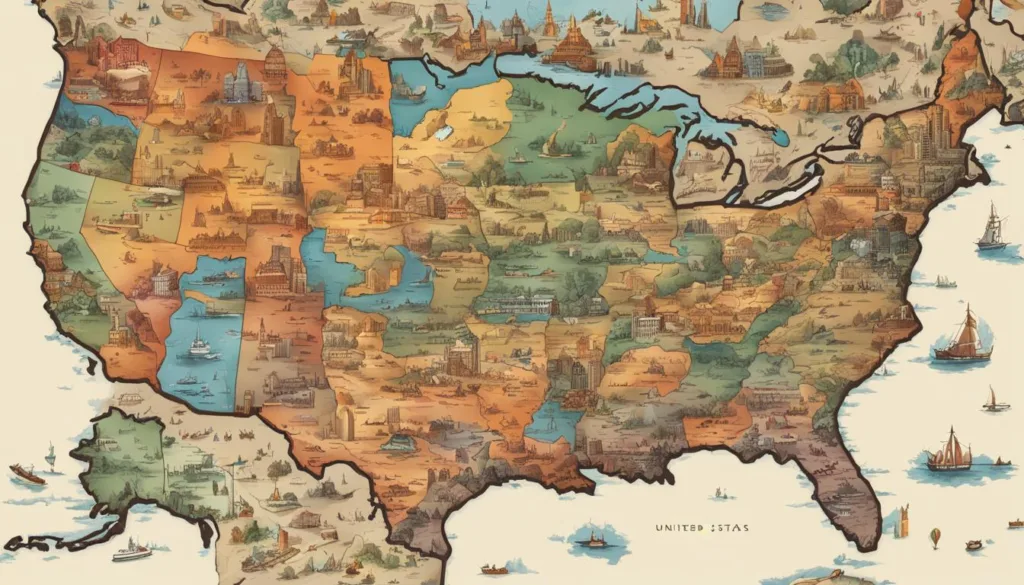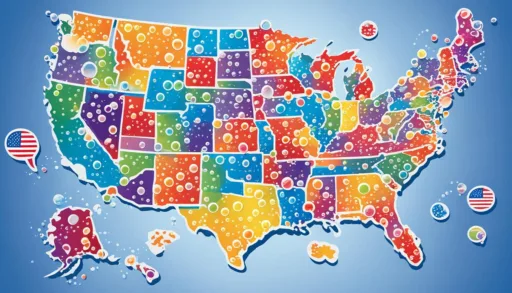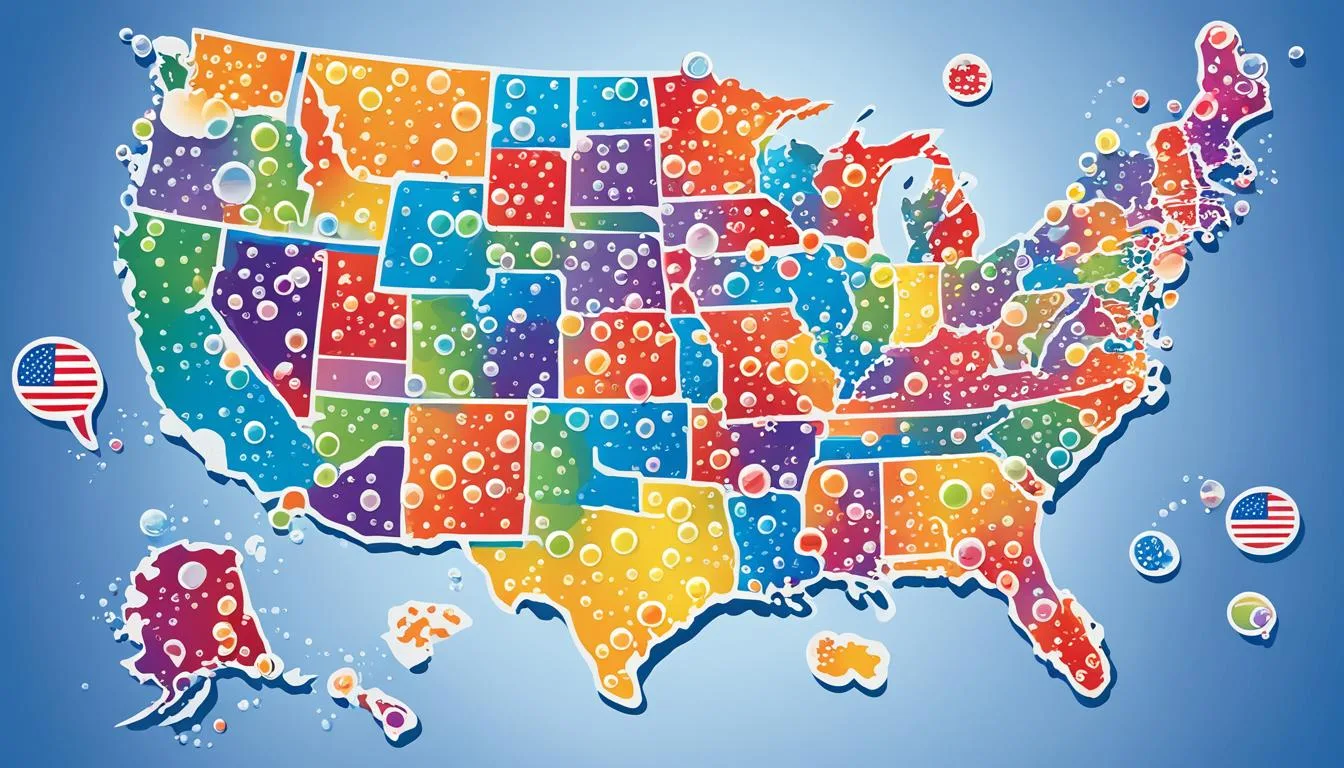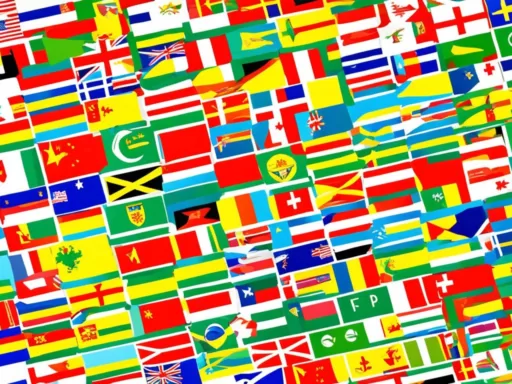Imagine a country where, in nearly one-fifth of homes, conversations flow in a symphony of languages other than the national tongue. That’s the unexpected reality of modern America. A startling U.S. Census Bureau revelation from 2019 paints a picture unlike the conventional expectations: close to 67.8 million people, nearly 1 in 5, communicate in languages other than English within the comfort of their living rooms. This surging figure has ascended from a mere 1 in 10 in 1980. While the languages spoken United States are remarkably varied, the growth isn’t just in non-English dialects. English-only households have also seen an uptick, from 187.2 million to a staggering 241 million over the same period. Indeed, American language diversity is not just a footnote in cultural textbooks—it’s a living, thriving testament to the myriad narratives and backgrounds that interlace the vibrant social fabric of the U.S.
Key Takeaways
- A significant increase in non-English speaking households reflects America’s burgeoning linguistic diversity.
- Despite the rise of other languages, the number of English-only speaking homes has also grown.
- The changing demographic points to the complex and dynamic United States languages scenario.
- Understanding language usage in America offers insights into the cultural and social evolution of the nation.
- The 1980 to 2019 period showcases how the American linguistic landscape has transformed, becoming more inclusive of various world languages.
- Awareness of American language diversity can foster better communication and community-building strategies.
Linguistic Diversity in America: A Melting Pot of Languages
The sheer range of linguistic diversity in the USA is a testament to its long-standing reputation as a melting pot of cultures and languages. With residents who trace their ancestries to all corners of the globe, the result is a rich tapestry of languages of America being spoken across the nation. This kaleidoscope of tongues is not only a cultural phenomenon but a living, evolving characteristic of American society.
While English is the lingua franca for the majority, a multitude of popular languages in the United States find their place in daily communication. These are not just mere remnants of heritage; they are vibrant, full-fledged modes of expression that thrive in communities large and small. The social fabric of the nation thus includes a stunning variety from the major languages other than English to indigenous and immigrant tongues.
- Spanish – A reflection of the strong Hispanic influence, particularly in states like California, Texas, and Florida.
- Chinese (Mandarin and Cantonese) – A vital part of linguistic culture, especially in vibrant city enclaves.
- Tagalog – Connecting Filipino-American communities, showing the impact of the Philippines’ heritage.
- Vietnamese – Indicative of a significant population, particularly in areas such as Orange County, California.
- French – Still spoken in regions with historical ties to France, like Louisiana and parts of Maine.
Furthermore, a wondrous array of dialects in the US underscore the intricate regional differences that define the nation’s soundscape. From the distinctive drawl of the Deep South to the clipped cadence of New England and the Midwest nasal intonations, each linguistic variation adds a unique flavor to the American English language and reflects the diverse history of settlement in the country.
The American linguistic mosaic is undergoing continuous change, welcoming new vernaculars with each wave of immigrants. As a result, the linguistic panorama of the United States is one of constant evolution—a dance of traditions and transitions that speaks volumes about the country’s past, its present, and the direction it is heading towards.
Languages Spoken United States: The Top Languages After English
The cultural tapestry of America is rich and varied, with linguistic threads that crisscross the national fabric, connecting communities with their ancestral roots and with each other. The most spoken languages in the US after English highlight the nation’s ever-evolving nature, with the Spanish language in the US leading the way as a defining voice in a chorus of diversity. This linguistic landscape continues to be shaped by various factors, including immigration, demographic shifts, and the preservation of cultural identity.
Spanish: A Dominant Linguistic Force
In the realm of most spoken languages in the US, Spanish stands tall as the second most prevalent language, an assertion supported by a robust Hispanic presence. This linguistic staple within American households offers a testament to the interlaced fabric of cultures that give the United States its distinctive character.
Chinese Variants: Reflecting a Robust Cultural Influence
A tapestry of tones and traditions, the Chinese language in the US encompasses variants like Mandarin and Cantonese. This diversity within a single linguistic group mirrors the dynamism of the Chinese-speaking diaspora and its profound imprint on the American cultural mosaic.
Tagalog: The Language of the Philippines in America
Tagalog, along with its national iteration Filipino, resonates within the US as the embodiment of Filipino heritage and unity. Its significance extends beyond communication, serving as a vibrant thread intertwining the Filipino American community with the fabric of US society.
French and Vietnamese: Historical Ties and Contemporary Presence
The presence of French and Vietnamese languages in the US is a nod to the historic and present-day tapestry of migrations and cultural exchanges. Within the symphony of spoken words across the nation, these languages provide notes of legacy and adaptation.
| Language | Community Size | Cultural Influence |
|---|---|---|
| Spanish | ~42 million | Largest minority language |
| Chinese | ~3.49 million | Significant Asian linguistic presence |
| Tagalog | ~1.7 million | Reflective of Filipino migration |
| French | ~1.18 million | Historical European link |
| Vietnamese | ~1.52 million | Indicative of Southeast Asian community ties |
Official vs. Unofficial: Understanding US Language Policies
The intricacies of US language policies weave a complex web, reflective of its multifaceted society. Though the United States stands without an official language at the federal level, the ubiquitous presence of English positions it as the de facto tongue of the nation. This is further emphasized by state legislatures in which English has been anointed as the official language, promoting its preeminence.
A tapestry of tongues finds its voice within the US populace, mirroring the vast array of ethnic identities that call the country home. Below is a table providing an overview of the various states in which English stands as the legally recognized official language, delineating the US’s quasi-homogenous language policies.
| State | Status of English as Official Language |
|---|---|
| California | Yes |
| Arizona | Yes |
| Florida | Yes |
| Hawaii | English and Hawaiian |
| Illinois | Yes |
Despite the legislative emphasis on English, the spirit of diversity is omnipresent, with communities across the nation espousing a variety of vernaculars reflecting their rich cultural backgrounds. Debate continues regarding the adoption of an official language in US at a national level, however, the current policies at state levels undoubtedly shape the linguistic identity of the US.
English Dominance and the Role of American English as the Lingua Franca
The fabric of the United States has long been woven with threads of linguistic variety, but the English language in the US stands out as the binding thread in this diverse tapestry. Known for its American English dominance, the language serves as the cornerstone for communication across this vast nation. Its prevalence is not just a matter of numbers but a key element in the cultural and functional quotidian of American life.
Within the realm of governance, education, and media, American English operates as the backbone, enabling a shared understanding amongst its myriad of speakers. Even in regions teeming with linguistic diversity, English is the medium through which different cultures converse and coalesce. This establishes it as the de facto lingua franca, essential for not only domestic harmony but also as an instrumental tool in international dialogue.
| Statistic | Data |
|---|---|
| Number of American English speakers at home | Approximately 239 million |
| Percentage speaking English “very well” | Significant majority |
| Role in Government functions | Primary language used |
Despite other languages spoken within family units or communities, proficiency in English remains high. This underpins the accessibility and inclusivity that the language provides, making it an indispensable asset for citizens from various ethnic backgrounds. Whether in bustling cityscapes or serene small towns, mastery of English is a shared commonality among Americans. It’s the linguistic currency that powers the engine of the nation’s culture, commerce, and conversation.
English is not just a language in the US—it’s an integral part of the American identity, an enabler of dreams, and a facilitator of opportunities.
As such, while the United States celebrates its linguistic diversity, it’s the pervasive use of American English that narrates the story of the nation, past, present, and future.

Immigrant Languages and their Impact on the US Cultural Tapestry
The United States has long been a crucible for cultural fusion, prominently showcased through its evolving language scape. As the fabric of American society is continually woven with strands from around the globe, the linguistic contributions of immigrants play an essential role in shaping the nation’s cultural identity. This unique American linguistic integration sees new residents preserving their native tongues while embracing English, thus enriching the American cultural tapestry.
Cultural Integration and Language Retention
If there’s one thing that stands as a testament to the resilience of cultural identity, it is the steadfastness of language retention in the US among immigrant communities. From the bustling streets of Little Italy to the vibrant neighborhoods of Chinatown, languages from distant shores reverberate, creating a multicultural soundscape. As newer generations of immigrants forge their path in American society, they tread the delicate balance of cultural integration while holding onto the linguistic cords that connect them to their heritage.
Emerging Languages from Recent Immigrant Groups
Parallel to the well-established linguistic communities are the voices of recent immigrant languages in the US. These tongues may be less commonly heard but are rapidly becoming part of the nation’s linguistic mosaic. Haitian Creole echoes in the corridors of Florida schools, while Telugu and Bengali words are exchanged in Silicon Valley’s tech hubs and New York’s cabs. Each brings its own flavor, adding nuances to the American cultural experience and reflecting a continuous influx of rich and diverse human experiences.
The Hispanic Influence and Spanish Language Flourishment in the US
The fabric of American language is rich and complex, woven with threads of historical and present-day influences. Central to this linguistic tapestry is the significant role of the Hispanic population. The United States boasts a dynamic and robust Spanish-speaking community, where the language flourishes with a varied spectrum tied closely to heritage and region.
Spanish is not a monolith within the boundaries of the nation; it is a living, evolving entity that takes on distinctive forms as it is influenced by the intricacies of regional cultures. These variations across the states not only signify the geographical diversity of Hispanic communities but also echo the stories of migration, settlement, and societal impact.
Regional Variations of Spanish Across the States
The United States serves as a stage where regional Spanish variations tangibly showcase the diversity of Hispanic heritage. From the Southwest to the East Coast, these regional dialects reveal the multifaceted nature of Spanish-language presence.
In states like New Mexico and Texas, one encounters a Spanish deeply intertwined with historical roots, often referred to as New Mexican Spanish. In contrast, the rich Cuban and Puerto Rican influences in places like Miami give rise to a Caribbean-infused dialect, palpable in both rhythm and vocabulary. Each region imparts its own flavor to the Spanish language, crafting a linguistic map as varied as the landscapes themselves.
Nativity and the Bilingual Nature of Hispanic Communities
Bilingualism thrives among Hispanic communities in the United States, infusing daily life with a symphony of English and Spanish. This bilingual nature is not confined to immigrant populations but is also fervently preserved among U.S.-born Spanish speakers. Navigating social, cultural, and professional realms, these bilingual individuals embody a harmonious blend of linguistic duality that enriches both their communal and national identities.
The phenomenon of Spanish-English bilingualism has sparked unique societal dynamics and has contributed significantly to various sectors in the U.S., from commerce to entertainment, demonstrating the adaptability and resilience of Hispanic heritage in the face of a predominantly English-speaking society.

This blend of languages within the Hispanic populace serves as a testament to the enduring impact and proliferating influence of the Spanish language in the United States. As generations evolve, so does the linguistic legacy, promising a future where the flourish of Spanish amidst the English backdrop remains an indelible strand in the American cultural fabric.
Native American Languages: Preservation and Importance
The tapestry of American linguistic heritage is rich and complex, with indigenous languages preservation in the US taking a central spot in efforts to maintain the country’s diverse cultural identity. The journey toward safeguarding Native American dialects in the US is laden with challenges but brims with passionate resolve and innovation.
Efforts to Revitalize Indigenous Languages
Revitalization programs are pivotal in the preservation of indigenous languages. Across the nation, initiatives such as language immersion schools, digital archiving, and curriculum development are undertaken to breathe new life into these ancestral tongues. The collective aim is not merely to prevent linguistic extinction but to reaffirm the value these languages hold in the heritage and identity of Native American communities.
Diverse Native Languages and Dialects in Modern America
The landscape of Native American dialects in the US is one of both beauty and concern. From the expanses of the Navajo Nation to the forests where Cherokee whispers still linger, there is a concerted push to ensure these voices do not fade away. Programs are specifically designed to cater to the varying degrees of language vitality, aiming for a resurgence of use in both ceremonial contexts and daily interactions.
| Language | Speakers | Revitalization Initiatives |
|---|---|---|
| Navajo | Approx. 150,000 | Language immersion schools, community classes |
| Cherokee | Approx. 2,000 | Digital documentation, language apps |
| Choctaw | Under 10,000 | Cultural preservation programs, language camps |
| Ojibwe | Approx. 8,000 | Educational resources development, mentorship programs |
| Lakota | Approx. 2,000 | Intensive language workshops, revitalization conferences |
The efforts to preserve indigenous languages in the US showcase not only a commitment to cultural diversity but also a profound respect for the historical legacies these languages represent. They carry the stories, wisdom, and traditions of the Native American peoples and form an irreplaceable thread in the fabric of American society.
American Sign Language and Other Non-Spoken Languages
Within the diverse linguistic culture of the United States, American Sign Language (ASL) has emerged as a cornerstone of communication among the hearing-impaired community. As a non-spoken language rich in expression and nuance, ASL is distinct yet equally as complex and robust as spoken languages. Beyond ASL, various other non-verbal communication forms offer a fascinating glimpse into the multitude of ways people connect in the US.
These non-spoken languages have developed within unique cultural enclaves, supporting rich traditions and histories. They serve as a testament to the ingenuity and adaptability of human communication. In this context, languages such as Navajo Family Sign and Plains Indian Sign Language not only cater to specific communication needs but also carry cultural significance and heritage.

The following table provides a snapshot of non-spoken language diversity in the US:
| Language | Community | Characteristics |
|---|---|---|
| American Sign Language (ASL) | Hearing-Impaired & Deaf Community | Complete language with its own syntax, grammar, and lexicon |
| Navajo Family Sign | Navajo Families | Home-based system with signs adapted from ASL and indigenous elements |
| Plains Indian Sign Language | Various Native American Tribes | Historic trade language with wide-reaching intertribal use |
As non-spoken languages continue to thrive in various US communities, they underscore the importance of inclusivity and cultural preservation. These languages offer an essential bridge for individuals to engage fully with society, maintaining social bonds and ensuring that every voice is heard. The acknowledgment and support of American Sign Language and other non-spoken forms is pivotal, enriching the linguistic tapestry of the nation.
The Evolution of English in the US: Loanwords and Linguistic Borrowing
The myriad of languages spoken in the melting pot of the United States has profoundly impacted American English, peppering it with fascinating loanwords. A significant portion of this linguistic exchange flows from the enduring Spanish influence on American English as well as the indelible impact of various Asian languages. This section delves into how these influences have enriched American vocabulary and cultural expression.
Influence of Spanish on the American Lexicon
From the sultry rhythms of flamenco to the delectable zest of tacos, the Spanish influence on American English is undeniable. It’s reflected in the adoption of words that are now so commonplace, they are often mistaken for English. The imprint of Spanish is particularly evident within the United States’ vast array of place names, from Los Angeles to San Antonio, underscoring the historical and ongoing integration of Spanish culture into the American fabric. Additionally, everyday vernacular has absorbed Spanish words and phrases with aplomb, showcasing a natural linguistic crossover.
Asian Languages Contributions to American English
The Asian language influence on American English is as varied as it is profound. Loanwords from Chinese, Tagalog, Vietnamese, and other Asian languages have permeated the American English lexicon, often bringing with them rich cultural narratives. The food industry, in particular, showcases this linguistic amalgamation, where words like “dim sum” and “pho” are not just menu items, but gateways to the vast and intricate world of Asian cultures. Beyond cuisine, colloquial terms and phrases adopted into everyday speech act as a testament to the multicultural heartbeat of the nation and the fluid, ever-adaptive nature of language.
It’s clear that the threads of Spanish and Asian languages are intricately woven into the very fabric of American English, reflecting a history of diversity and collaboration. This linguistic tapestry continues to evolve as American English embraces and integrates words from the invaluable contributions of these rich cultures.
Conclusion
The US language landscape offers a compelling narrative about the nation’s evolving cultural and societal framework. It is a canvas painted with the words and expressions of those who call the United States home, showcasing an all-encompassing environment where the languages spoken in the United States color the national identity. English may be the predominant language, familiar on the tongues of millions, yet it thrives alongside a multitude of languages, each echoing the diverse histories of its speakers.
America’s linguistic fabric is woven with threads of Spanish, Chinese, Tagalog, and many more, each thread signifying an integral part of the nation’s cultural tapestry. This linguistic diversity is more than a characteristic feature—it is a testament to the country’s perpetual dance with immigration and the embrace of global interconnectedness. The spectrum of dialects and tongues underscores the strength found in pluralism, reflecting America’s ethos of unity in diversity.
As the United States continues to evolve, the tapestry of its languages will too. The rich amalgam that forms the current language matrix is a powerful reminder of the traditions preserved and shared amongst the American populace. Through the vibrancy and dynamism of its linguistic makeup, the nation illustrates the enduring legacy of cultural fusion, ensuring that the various languages spoken will remain a cornerstone of America’s collective heritage for generations to come.
FAQ
What are the most common languages spoken in the United States?
English is the most common language spoken at home in the United States, followed by Spanish. Other prominent languages include Chinese, Tagalog, Vietnamese, French, Korean, and a variety of others, reflecting the rich **linguistic diversity in the USA**.
How does the linguistic landscape in America reflect its cultural diversity?
The diversity of **languages of America**, from the many **dialects in the US** to the range of languages spoken at home, mirrors the country’s multicultural fabric. With people from different backgrounds and origins, language is a vital expression of America’s rich cultural diversity.
Is English the official language of the United States?
At the federal level, the United States does not have an official language. However, **English language in US** functions as the de facto national language used in governmental proceedings, and 32 states have enacted legislation declaring English their official language.
How does the Spanish language influence the US linguistic scene?
**Spanish language in US** is the second most spoken language and it influences the US linguistic scene through regional dialects, loanwords in English, and by contributing to the bilingual nature of many Hispanic communities, demonstrating the language’s significant cultural impact.
Are indigenous languages still spoken in the US today?
Yes, indigenous languages are still spoken, though many are endangered. There are ongoing efforts to revitalize these languages as part of the cultural heritage, including Navajo, Cherokee, and Choctaw among others, which form part of the diverse **Native American dialects in US**.
What is the significance of American Sign Language in the US?
**American Sign Language** (ASL) is essential for the deaf and hard of hearing community in the US, facilitating communication and access to services. It is a fully-developed and recognizable language integral to the **non-spoken languages in US**.
How have recent immigrant groups affected the languages spoken in the US?
Recent immigrant groups have introduced a spectrum of languages, such as Haitian Creole, Telugu, and Bengali, adding to the **US language landscape**. These communities contribute to the **linguistic diversity in USA** while simultaneously integrating into American society and culture.
What role does English play in the United States?
English is the dominant language and serves as the **lingua franca** within the United States, used for education, official government business, and everyday communication. Despite the linguistic diversity, **American English dominance** prevails in public and private life.
How have Asian languages influenced American English?
Asian languages have left an imprint on American English with loanwords, particularly in the realms of food, culture, and everyday speech. This reflects the broader influence of Asian American communities and the integration of their linguistic heritage into **languages spoken United States**.
Are there any significant Arabic or Russian speaking populations in the US?
Yes, there are significant communities of Arabic and Russian speakers in the United States. These populations are part of the **recent immigrant languages in US**, contributing to the nation’s **American linguistic integration** and diversity.
Can learning a second language in the U.S. offer advantages?
Learning a second language offers numerous advantages, including better cognitive abilities, enhanced career opportunities, and deeper cultural understanding. In the multicultural setting of the US, bilingualism can facilitate communication and foster inclusivity in diverse environments.






